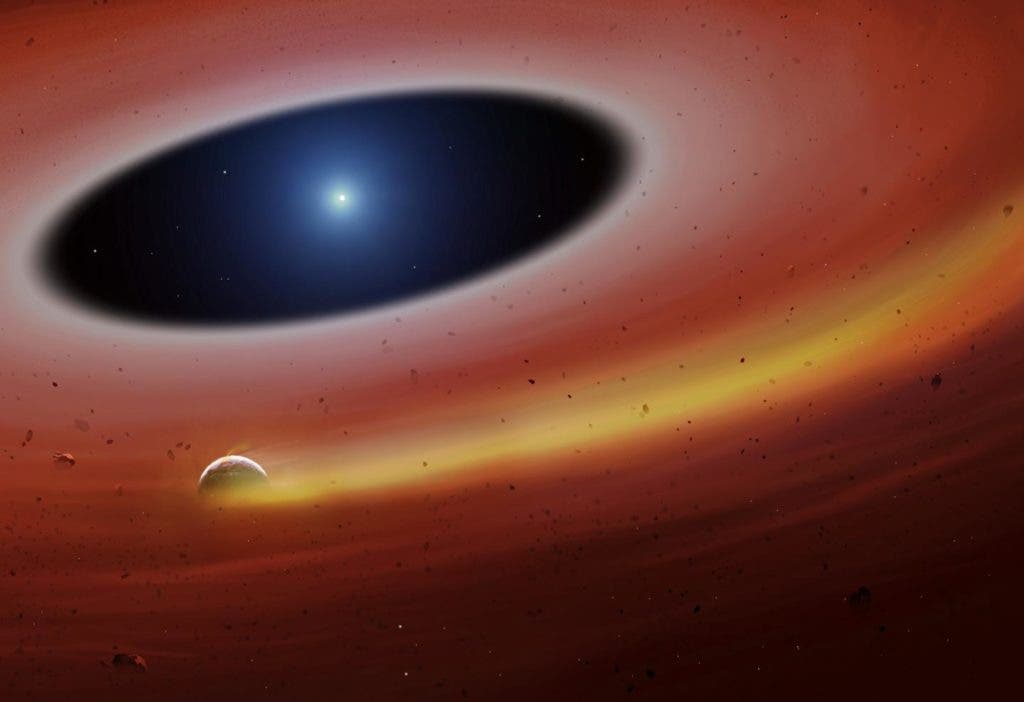
Astronomers have discovered a planetary body orbiting a white dwarf — the remaining compact core of a deaf low-mass star. This discovery hints at what conditions Earth might encounter when the Sun begins to die, billions of years from now.
Planetary leftovers
The observable universe is littered with white dwarf stars, however, this was one of the few rare occasions that scientists have discovered orbiting debris around such a star. The planetesimal, which lies 410 light-years from Earth in the constellation Virgo, is believed to be no larger than a couple of hundreds of miles in diameter.
When a star similar in size to the Sun runs out of fuel, it starts expanding greatly in size into a red giant. As it does so, its intense gravity is capable of ripping apart any closely orbiting planets. Astronomers think that this is what happened to the small rocky body that they’ve observed, which probably used to be a dense planet.
When our sun will go through the same process in about 5 billion years, it will obliterate everything inside Mars’ orbit and disrupt the orbit of planets further out. The survival of life on Earth under these conditions is out of the question and scientists are still debating whether our planet will physically survive or be devoured by the sun. These latest findings suggest a bleak outcome is very likely.
The star would have originally been about two solar masses, but now the white dwarf is only 70% of the mass of our Sun. It is also very small – roughly the size of the Earth – and this makes the star, and in general all white dwarfs, extremely dense,” Manser said in a statement.
“The white dwarf’s gravity is so strong – about 100,000 times that of the Earth’s – that a typical asteroid will be ripped apart by gravitational forces if it passes too close to the white dwarf.”
In order to find the planetesimal, researchers led by University of Warwick astrophysicist Christopher Manser employed a method called spectroscopy, which involves analyzing the different wavelengths of light emitted by an object. With the help of the Gran Telescopio Canarias in La Palma, Spain, the team of astronomers detected changes in the color of light emitted by a disc around the white dwarf known as SDSS J122859.93+10432.9, orbiting with a period of two to three minutes. The disc has a comet-like tail and is mostly made of iron, nickel, and other metals. It is the second solid remnant of a planet to have ever been discovered orbiting a white dwarf.
“The general consensus is that 5-6 billion years from now, our Solar System will be a white dwarf in place of the Sun, orbited by Mars, Jupiter, Saturn, the outer planets, as well as asteroids and comets. Gravitational interactions are likely to happen in such remnants of planetary systems, meaning the bigger planets can easily nudge the smaller bodies onto an orbit that takes them close to the white dwarf, where they get shredded by its enormous gravity,” Manser said.
Other objects might still orbit the dying distant star. However, the white dwarf is so faint that astronomers are unable to see anything orbiting farther out with their current tools. In the future, Manswer and colleagues plan on using spectroscopy to discover other planetary fragments orbiting white dwarfs.
“Learning about the masses of asteroids, or planetary fragments that can reach a white dwarf can tell us something about the planets that we know must be further out in this system, but we currently have no way to detect,” Manser concluded.
The findings appeared in the journal Science.


